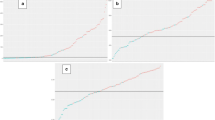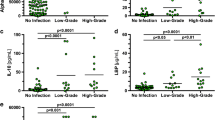Abstract
Purpose
Our aim was to define the effect of multiple biomarkers of osteolysis or bone remodelling in the early detection of aseptic loosening (AL) of total hip arthroplasty (THA).
Method
One hundred subjects were recruited, including 31 candidates for revision THA (Late AL group), 15 patients who had undergone THA and had clinical and radiographic evidence of AL (early AL group), 19 patients with no sign of AL (stable group), and 40 healthy volunteers. Plasma levels of osteoprotegerin (OPG), receptor activator of nuclear factor-kappaB ligand (RANKL), cross-linked N-terminal telopeptide (NTX), procollagen I C-terminal extension peptide (PICP), tumour necrosis factor-alpha (TNF-α), and interleukin (IL)-1β1 were measured using an immunoenzymatic method. The outcomes of biomarkers were analysed separately and synthetically using Revman software.
Results
The plasma level of OPG, RANKL, NTX, TNF-α, and IL-1β declined from late AL, early AL, stable to the healthy group, while the level of PICP inclined reversely. There was a significant difference in synthetic analysis of six biomarkers between the AL group and the stable group, and between the stable group and the healthy group (both p = 0.02). Heterogeneity of six biomarkers in either comparison was extremely low (both I2 =0). Patients who had cemented implants had significantly higher levels of TNF-α than patients with cementless varieties (p = 0.042).
Conclusion
There was significant change in the plasma level of multiple biomarkers in patients with prosthetic AL of THA, especially in the cemented arthroplasties and in patients without traditional clinical or radiographic evidence of AL.



Similar content being viewed by others
References
Malchau H, Herberts P, Ahnfelt L (1993) Prognosis of total hip replacement in Sweden: follow-up of 92,675 operations performed 1978–1990. Acta Orthop Scand 64:497–506
Purdue PE, Koulouvaris P, Potter HG (2007) The cellular and molecular biology of periprosthetic osteolysis. Clin Orthop Relat Res 454(1):251–261
Hernigou P, Intrator L, Bahrami T et al (1999) Interleukin-6 in the blood of patients with total hip arthroplasty without loosening. Clin Orthop Relat Res 366:147–154
Hundrić-Haspl Z, Pecina M, Haspl M et al (2006) Plasma cytokines as markers of aseptic prosthesis loosening. Clin Orthop Relat Res 453(12):299–304
Granchi D, Pellacani A, Spina M et al (2006) Serum levels of osteoprotegerin and receptor activator of nuclear factor-kappaB ligand as markers of periprosthetic osteolysis. J Bone Joint Surg Am 88(7):1501–1509
Savarino L, Granchi D, Cenni E et al (2005) Systemic cross-linked N-terminal telopeptide and procollagen I C-terminal extension peptide as markers of bone turnover after total hip arthroplasty. J Bone Joint Surg Br 87-B:571–576
Li MG, Thorsen K, Nilsson KG (2004) Increased bone turnover as reflected by biochemical markers in patients with potentially unstable fixation of the tibial component. Arch Orthop Trauma Surg 124:404–409
Lavernia CJ, Alcerro JC (2011) Quality of life and cost-effectiveness 1 year after total hip arthroplasty. J Arthroplasty 26(5):705–709
Gruen TA, McNeice GM, Amstutz HC (1979) “Modest of failure” of cemented stem-type femoral components: a radiographic analysis of loosening. Clin Orthop 141:17–27
Delee JG, Charnley J (1976) Radiological demarcation of cemented sockets in total hip replacement. Clin Orhop 121:20–32
Harris WH (1969) Traumatic arthritis of the hip after dislocation and acetabular fractures: treatment by mold arthroplasty: an end result study using a new method of evaluation. J Bone Joint Surg Am 51-A:737–755
TNC Centre (2011) Review manager (RevMan), 5.1 for Windows edn. The Cochrane Collaboration, Copenhagen
Schmidt-Rohlfing B, Thomsen M, Niedhart C et al (2002) Correlation of bone and cartilage markers in the synovial fluid with the degree of osteoarthritis. Rheumatol Int 21:193–199
Li YL, Wang L, Li J, Huang Y et al (2011) The correlation between uric acid and the incidence and prognosis of kidney diseases: a systematic review and meta-analysis of cohort studies. Chin J Intern Med 50:555–561
Mertens MT, Singh JA (2011) Biomarkers in arthroplasty: A systematic review. Open Orthop J 5:92–105
Savarino L, Avnet S, Greco M (2010) Potential role of tartrate-resistant acid phosphatase 5b (TRACP 5b) as a surrogate marker of late loosening in patients with total hip arthroplasty: a cohort study. J Orthop Res 28(7):887–892
Schwarz EM, Lu AP, Goater JJ et al (2000) Tumor necrosis factor alfa/nuclear transcription factor-kappa B signaling in periprosthetic osteolysis. J Orthop Res 18:472–480
Sipniewska G, Lis K, Bilinski PJ (2002) Bone turnover markers and cytokines in joint fluid: analyses in 10 patients with loose hip prosthesis and 39 with coxarthrosis. Acta Orthop Scand 73:518–522
Urban RL, Shanbhag AS, Lee SH et al (1996) Particulate-induced, prostaglandin and cytokine mediated bone resorption in an experimental system and failed joint replacements. Am J Ther 3:27–41
Lassus J, Salo J, Jiranek WA et al (1998) Macrophage activation results in bone resorption. Clin Orthop Relat Res 352:7–15
van der Heide HJ, van der Kraan PM, Rijnberg WJ et al (2010) Elevated levels of numerous cytokines in drainage fluid after primary total hip arthroplasty. Int Orthop 34:1099–1102
Takagi M, Santavirta S, Ida H et al (2001) High-turnover periprosthetic bone remodeling and immature bone formation around loose cemented total hip joints. J Bone Miner Res 16:79–88
Arabmotlagh M, Sabljic R, Rittmeister M et al (2006) Changes of the biochemical markers of bone turnover and periprosthetic bone remodeling after cemented hip arthroplasty. J Arthroplasty 21:129–134
Anderson DM, Maraskovsky E, Billingsley WL et al (1997) A homologue of the TNF receptor and its ligand enhance T-cell growth and dendritic-cell function. Nature 390:175–179
Lacey DL, Timms E, Tan HL, Kelley MJ et al (1998) Osteoprotegerin ligand is a cytokine that regulates osteoclast differentiation and activation. Cell 93:165–176
Masui T, Sakano S, Hasegawa Y et al (2005) Expression of inflammatory cytokines, RANKL and OPG induced by titanium, cobalt-chromium and polyethylene particles. Biomaterials 26:1695–1702
Kim KJ, Kotake S, Udagawa N et al (2001) Osteoprotegerin inhibits in vitro mouse osteoclast formation induced by joint fluid from failed total hip arthroplasty. J Biomed Mater Res 58:393–400
Zhou X, Zhang P, Zhang C et al (2010) Promotion of bone formation by naringin in a titanium particle-induced diabetic murine calvarial osteolysis model. J Orthop Res 28(4):451–456
Kovacik MW, Gradisar IA, Haprian JJ et al (2000) Osteolytic indicators found in total knee arthroplasty synovial fluid aspirates. Clin Orthop Relat Res 379:186–194
Woitge HW, Petchersdorfer M, Li Y et al (1999) Novel serum markers of bone resorption: clinical assessment and comparison of established urinary indices. J Bone Miner Res 14:782–801
Shanbhag AS, Kaufman AM, Hayata K et al (2007) Assessing osteolysis with use of high-throughout protein chips. J Bone Joint Surg Am 89:1081–1089
Author information
Authors and Affiliations
Corresponding author
Rights and permissions
About this article
Cite this article
He, T., Wu, W., Huang, Y. et al. Multiple biomarkers analysis for the early detection of prosthetic aseptic loosening of hip arthroplasty. International Orthopaedics (SICOT) 37, 1025–1031 (2013). https://doi.org/10.1007/s00264-013-1837-1
Received:
Accepted:
Published:
Issue Date:
DOI: https://doi.org/10.1007/s00264-013-1837-1




